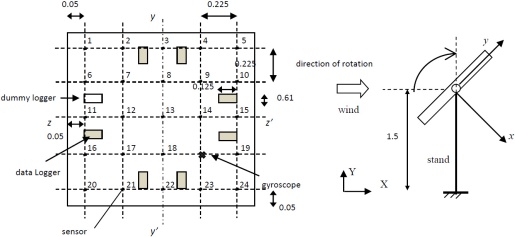The following are examples of past and current research undertaken by Dr Martinez-Vazquez:
The Flight of Windborne Debris - An Experimental, Analytical and Numerical Investigation

a) Test-sheet (front view)
b) Test-sheet on bearings (lateral view)
The aerodynamics of flat square plates were investigated by embedding a number of pressure sensors and portable data loggers within the thickness of plates of different characteristics. This technique allowed for the first time to observe the time variation of surface pressures on moving plates. A number of static and autorotational tests undertaken revealed the existence of complex flow structures that cannot be predicted by using standard experimental techniques. In addition, this investigation helped to correlate the pressure and flow fields on rotating plates which up to then had been studied separately.
Design Spectra for Wind Loading

Design spectra are normally applied in Seismic Engineering where it is assumed that the inertial forces induced by the horizontal accelerations acting at base of the structure are fully correlated. In the case of wind loading the amount of energy imparted by the wind to the structural system can be estimated for point-like structures as well as for large areas by considering suitable spatial correlation laws. In addition the use of generalised techniques allows considering the dynamic response of single oscillators whose ensemble response constitutes a design spectrum which in turn can be used to carry out modal analyses. Unlike similar spectral approaches design spectra would not restricted to cases in which the total response is mainly given by the fundamental mode of vibration but these would be applicable to the analysis of multiple degree of freedom systems where the contribution of higher order modes to the total dynamic response is important.
Wind Field Reproduction based on ANN and Conditional Simulation
Image recognition techniques (IR) allow the representation of one-dimensional wind time series as two-dimensional plots. This can be achieved by projecting the components of a one dimensional data series into a two dimensional space. The numerical version of several RPs can be assembled to form a subspace here referred to as eigen-space since it follows an eigen-value analysis that allows the redefinition of the data series in terms of short dimension vectors (Ω). IR allows the reconstruction of RPs based on their associated vector Ω. The correspondence RP-Ω can be mapped using an artificial neural network (ANN). The prediction of encoded time series through ANN permits their reconstruction in time domain because the process is reversible. ANN evolved from artificial intelligence to constitute a relatively modern tool with the objective of simulating the natural process of human learning.

The process shown in this figure was applied to identify the characteristics of wind at specific locations which were then used as reference points to apply the algorithm Conditional Simulation. In this was an ensemble of wind time series were generated to constitute a correlated wind field.
Predicting Wheat Lodging at Large Scales

The motion of a series of idealised wheat plants in the time domain subject to the application of a wind induced force were examined. A stochastic process representing the wind loading at different points over an imaginary field of wheat was generated. The plants were then modelled as damped harmonic oscillators and the wind induced response compared to the resistance offered by the root/soil and the plant stem. A comparison with a previous approximate method was also undertaken and a simple way to transform the approximate solutions to the full solution outlined here was provided. This computational method provides an alternative approach enabling plant failure over large populations to be predicted.
Source: Martinez-Vazquez P, Sterling M, 2011. Predicting wheat lodging at large scales. Biosystems Engineering, 109(4), 326-337.